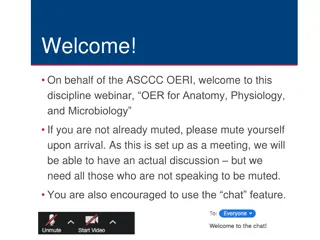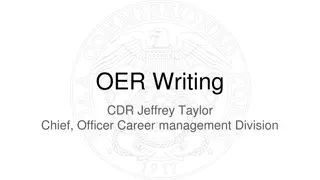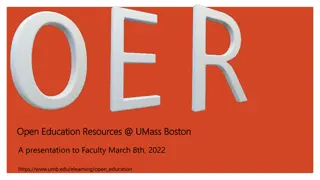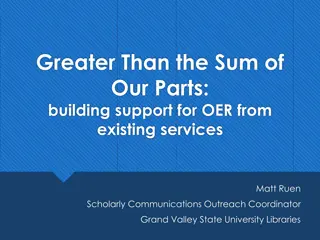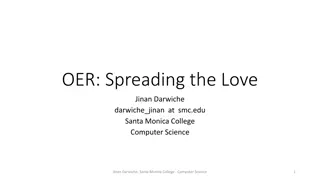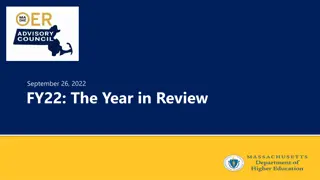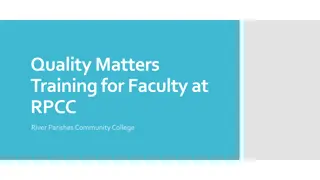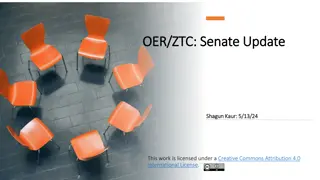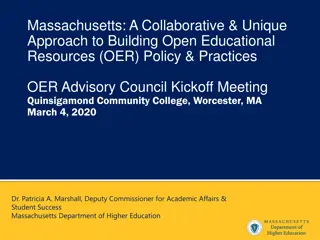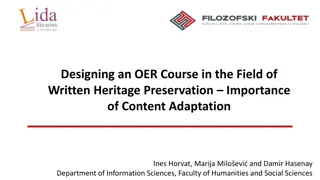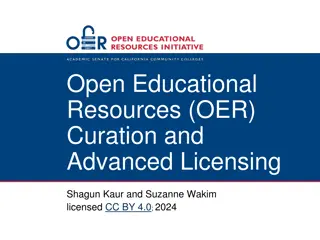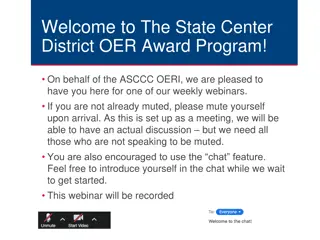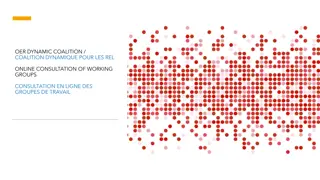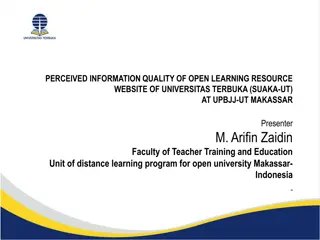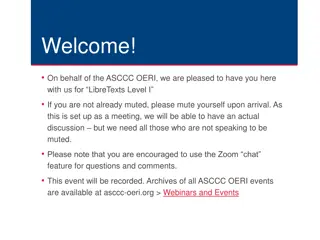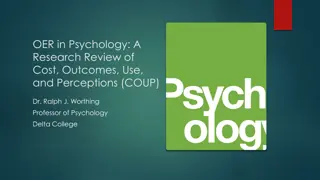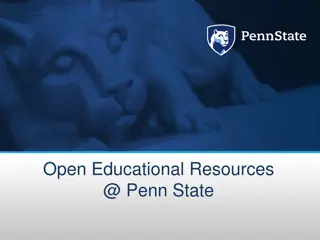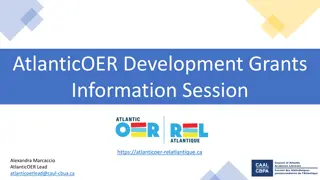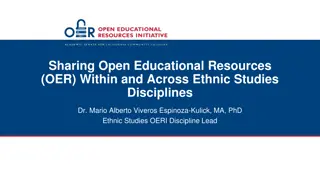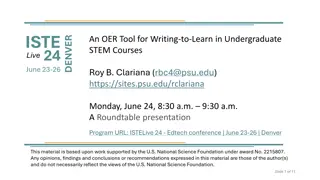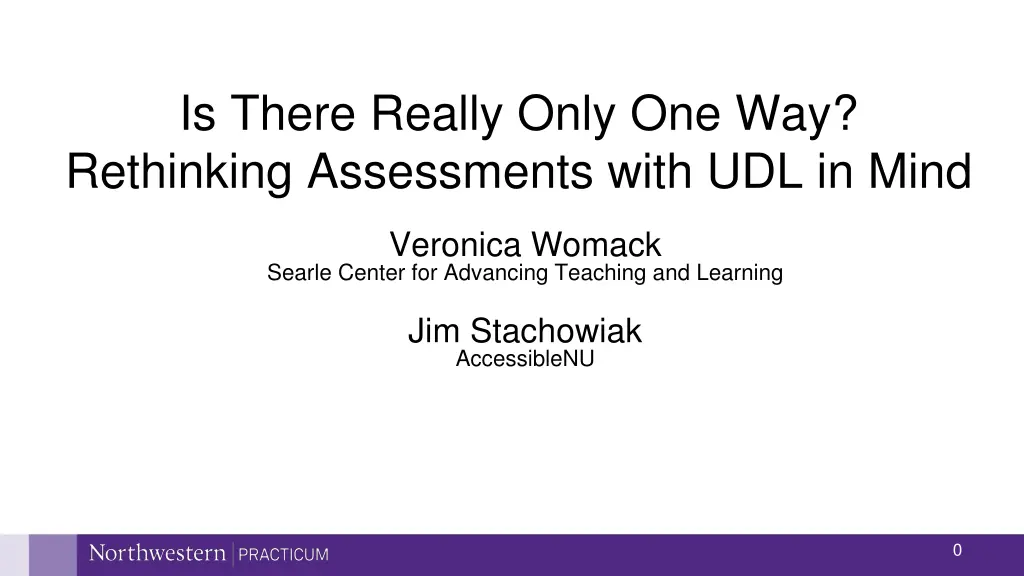
Rethinking Assessments with UDL in Mind: A New Approach
Explore how Universal Design for Learning (UDL) can revolutionize assessment strategies in education. Discover ways to reduce student anxiety, redefine learning objectives, and promote diverse means of expression to enhance teaching effectiveness.
Download Presentation

Please find below an Image/Link to download the presentation.
The content on the website is provided AS IS for your information and personal use only. It may not be sold, licensed, or shared on other websites without obtaining consent from the author. If you encounter any issues during the download, it is possible that the publisher has removed the file from their server.
You are allowed to download the files provided on this website for personal or commercial use, subject to the condition that they are used lawfully. All files are the property of their respective owners.
The content on the website is provided AS IS for your information and personal use only. It may not be sold, licensed, or shared on other websites without obtaining consent from the author.
E N D
Presentation Transcript
Is There Really Only One Way? Rethinking Assessments with UDL in Mind Veronica Womack Searle Center for Advancing Teaching and Learning Jim Stachowiak AccessibleNU 0
Learning Objectives 1. You will identify assumptions that serve as the basis for the design of current assignments and assessments. 2. You will apply at least one UDL-based approach to their class to reduce student anxiety around exams and deadlines while maintaining rigor. 3. You will critically examine course learning objectives to eliminate unnecessary components that restrict offering assignment options. 4. You will apply the UDL principle of multiple means of expression by redesigning one assignment to offer at least two options of delivery. 1
Defining Multiple Means of Expression The multiple ways that teachers can formatively or summatively evaluate students, as well as engage students in self-evaluation.1 There is no one means of action and expression that will be optimal for all learners; providing options for expression is essential.2 1 Kieran, L., & Anderson, C. (2019). Connecting universal design for learning with culturally responsive teaching. Education and Urban Society, 51(9), 1202-1216. 2 CAST UDL Guidelines 2
Pre-Session Reflections Do I expect my students to demonstrate that they are experts or that they are continual learners? Am I asking my students to articulate their mastery over the content or their relationship with the content? Am I prioritizing learning in isolation over learning in collaboration with others ? Do my assignments indicate my commitment to on-going learning, reflecting, and revisions for myself and my students? 3
Considerations When Centering Culture & Inclusion in Your UDL Practices Be aware of your students as individuals Actively address how power and privilege shape and block learning opportunities Build empowered communities of expert learners 4
Approaches to Learning Banking Model vs. Liberatory Model 5
Approaches to Learning Banking Model students = passive consumers should consume and memorize information disseminated by professor professors have nothing learn from students Adapted from hooks, Teaching to Transgress: Education as the Practice of Freedom 6
Approaches to Learning Liberatory Model everyone in the classroom is an active participant brings knowledge and expertise, not just the instructor invited to participate as full people knowledge is co-created by all participants through activity and dialogue Banking Model students = passive consumers should consume and memorize information disseminated by professor professors have nothing learn from students Adapted from hooks, Teaching to Transgress: Education as the Practice of Freedom 7
Connecting Multiple Means of Expression and Culturally Responsive Teaching honoring different methods of students sharing knowledge (i.e. storytelling, family histories) and valuing experiential knowledge and traditions providing opportunities for collaboration and reciprocal teaching acknowledging both Standard English and local discourse styles using metacognitive strategies to change students negative thought processes when they encounter learning challenges Kieran & Anderson, 2019 8
Expression of Learning Opportunities Worksheet Opportunities Formative Assessment What is the delivery methods for this assignment Summative Assessment Describe the format for this exam and why this is used? to state relayed information to demonstrate inquiry to reflect to revise to practice skill sets to collaborate with others 9
Small Group Discussion Questions 1. Describe how it felt to critically review your own assessments? 2. What did you notice about your assignments and exams ? 3. Did you recognize any hidden assumptions about your students? OR Were any assumptions uncovered? If so, where do you think these assumptions came from? 10
UDL and Exams Why Exams? Why This Way? Offer Flexibility Exams are a significant stress for students, but also part of the college experience Allow for makeups within reasonable time Create a backup exam Use old exams Create exams in Canvas and draw from question banks Give multiple chances to answer Canvas exams Offer take home exams focusing on application Offer a drop Offer correction options Why do you give exams? Why use the format you use? Is there another way? 12
UDL, Exams, & Deadlines Student Issues Potential Solutions Stress and anxiety build when students have deadlines and exams at the same time Avoid due dates during midterms Offer flexible due dates around midterms Offer short, no question extensions, especially for late deadlines Offer a set amount of late days at the beginning of the quarter that students can distribute as needed Offer more opportunities for points than points needed Students tend to focus more on the exams Assignment work suffers 14
UDL & Assignments - Add Options Use plus-one thinking to add one more option to an assignment Potential options: Paper Video Presentation Podcast Project 15
Why Provide Assignment Options? We are working to create expert learners, options encourage greater engagement Allows students to choose to develop skills or use strengths to further engage Can remove barriers to expressing learning Can give instructors more interesting end results 16
How Do We Offer Options? 1. Make sure learning objectives are clear and speak to what needs to be completed in the course. 2. Determine the skills (target skills) the assignment is assessing related to the learning objectives. 3. Determine the skills (access skills) used to complete current assignments that aren t necessary to align with the learning objectives. 4. Add one option that also allows for completion of learning objectives 17
Revisit Learning Objectives Do your current course learning objectives influence your assignment delivery method? YES NO Why? Is the assignment delivery method critical to your learning objectives? Consider using plus one thinking to add one more option to your assignment delivery method. YES NO Consider rewriting your LO s to allow options Options are not possible for this assignment 18
Determine Target Skills Make a list of the identified skills you are assessing for each assignment Compare the identified skills to your learning objectives Those that map to your learning objectives are target skills 19
Identifying Target Skills - Example Pick a conflict in which you are invested and then introduce this conflict to two different audiences in two different genres via a written summary. Each summary should include no less than 250 words. Whatever conflict, audiences, or genres you choose, the most important part of this assignment is that: The who, what, why and when of the conflict is clear Beyond the gist of the conflict, any other information you include will depend on your audience and the conventions of the genre you have chosen Think about what life experiences your readers are bringing to your text. Based on your word choice, the style and tone of your writing, and the images you include (or not), your intended audience should be clear. Target Skills Identify who, what, why, and when of conflict Clearly communicate who, what, why, where, when Demonstrate understanding of genre conventions Understand impact of audience life experiences Demonstrate ability to clearly connect with intended audience 20
Determine Access Skills List all skills needed to complete the assignment as currently designed Access Skill Examples Writing Spelling Reading fluency Working memory Attention Speaking Cross reference list with target skills and LO s Anything not explicitly tied to LO s is an access skill 21
Add Options Start with one assignment Add one other option with different access skills to complete Set the technical standards for your assignment 22
What About Grading? Develop Clear Rubrics Develop rubrics aimed at objectives that can be observed regardless of method Make sure students know what is and isn t being graded 23
Case Studies Choose one of the following break out rooms to discuss a case study: Questions to Consider 1. What would you do in the short term to apply UDL principles to assessments in this course? Room 1: Large Humanities/Social Science Class Room 2: Small Humanities/Social Science Class Room 3: Large STEM Class Room 4: STEM Lab Class 1. What would be potential longer term UDL solutions this instructor could implement around their assessments? 1. How would you address any potential difficulties or hesitancies you might experience in implementing UDL solutions in this class? 24
Addressing Hesitancies around Implementing UDL Solutions Reflect on what your hesitancies and why they exist Think of resources (internal and external) that will help you be open minded and creative Think of necessary structural support from your department Take an iterative approach, starting small and making additions over successive quarters Seek out support from others who have implemented elements of UDL successfully 25

